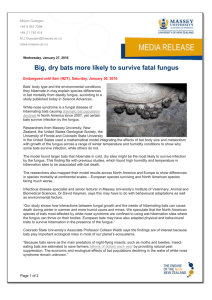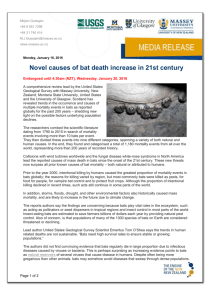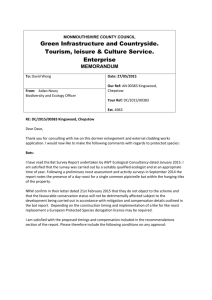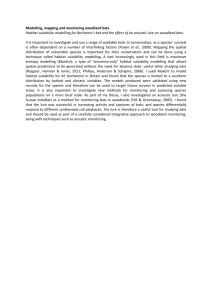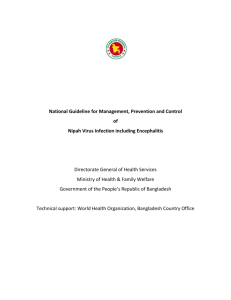Risk of Disease Transmission from Flying Foxes SEABCRU
advertisement
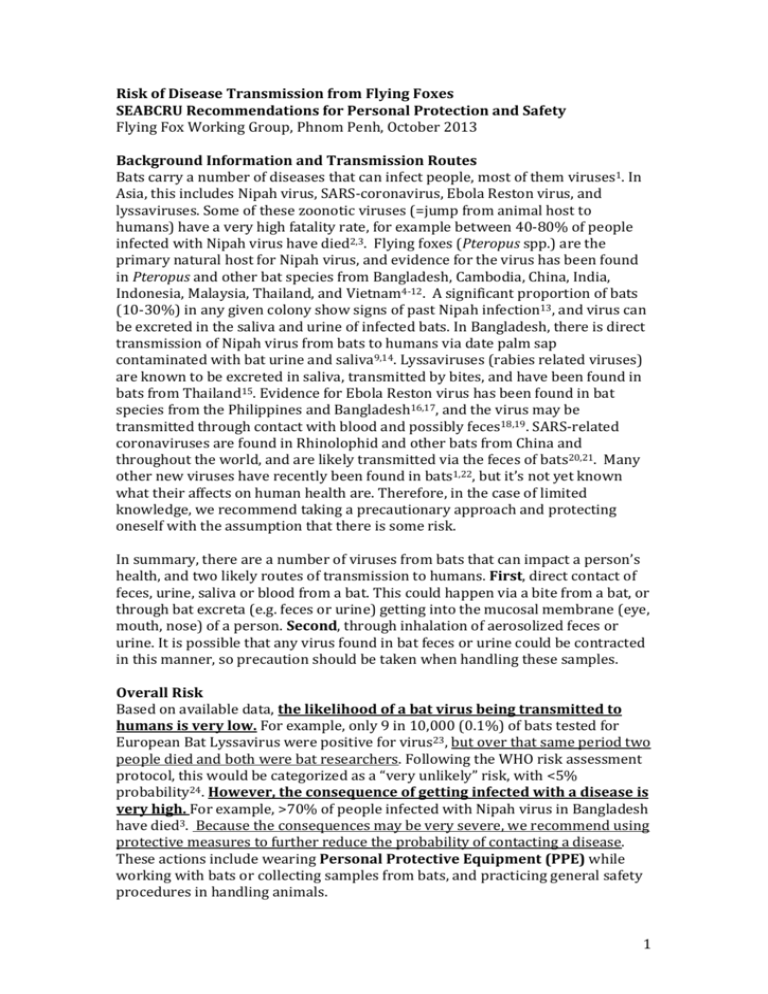
Risk of Disease Transmission from Flying Foxes SEABCRU Recommendations for Personal Protection and Safety Flying Fox Working Group, Phnom Penh, October 2013 Background Information and Transmission Routes Bats carry a number of diseases that can infect people, most of them viruses1. In Asia, this includes Nipah virus, SARS-coronavirus, Ebola Reston virus, and lyssaviruses. Some of these zoonotic viruses (=jump from animal host to humans) have a very high fatality rate, for example between 40-80% of people infected with Nipah virus have died2,3. Flying foxes (Pteropus spp.) are the primary natural host for Nipah virus, and evidence for the virus has been found in Pteropus and other bat species from Bangladesh, Cambodia, China, India, Indonesia, Malaysia, Thailand, and Vietnam4-12. A significant proportion of bats (10-30%) in any given colony show signs of past Nipah infection13, and virus can be excreted in the saliva and urine of infected bats. In Bangladesh, there is direct transmission of Nipah virus from bats to humans via date palm sap contaminated with bat urine and saliva9,14. Lyssaviruses (rabies related viruses) are known to be excreted in saliva, transmitted by bites, and have been found in bats from Thailand15. Evidence for Ebola Reston virus has been found in bat species from the Philippines and Bangladesh16,17, and the virus may be transmitted through contact with blood and possibly feces18,19. SARS-related coronaviruses are found in Rhinolophid and other bats from China and throughout the world, and are likely transmitted via the feces of bats20,21. Many other new viruses have recently been found in bats1,22, but it’s not yet known what their affects on human health are. Therefore, in the case of limited knowledge, we recommend taking a precautionary approach and protecting oneself with the assumption that there is some risk. In summary, there are a number of viruses from bats that can impact a person’s health, and two likely routes of transmission to humans. First, direct contact of feces, urine, saliva or blood from a bat. This could happen via a bite from a bat, or through bat excreta (e.g. feces or urine) getting into the mucosal membrane (eye, mouth, nose) of a person. Second, through inhalation of aerosolized feces or urine. It is possible that any virus found in bat feces or urine could be contracted in this manner, so precaution should be taken when handling these samples. Overall Risk Based on available data, the likelihood of a bat virus being transmitted to humans is very low. For example, only 9 in 10,000 (0.1%) of bats tested for European Bat Lyssavirus were positive for virus23, but over that same period two people died and both were bat researchers. Following the WHO risk assessment protocol, this would be categorized as a “very unlikely” risk, with <5% probability24. However, the consequence of getting infected with a disease is very high. For example, >70% of people infected with Nipah virus in Bangladesh have died3. Because the consequences may be very severe, we recommend using protective measures to further reduce the probability of contacting a disease. These actions include wearing Personal Protective Equipment (PPE) while working with bats or collecting samples from bats, and practicing general safety procedures in handling animals. 1 Assessing Risk and Appropriate Personal Protective Equipment (PPE) There is not a one size fits all solution to PPE, and you should modify what you wear based on your level of risk of exposure to bat saliva, urine, feces, or blood. In Figure 1, we present a flow chart to illustrate how PPE may differ when doing different bat research activities. Examples of different levels of exposure: High level of exposure: A high risk of exposure would include: working under a very active and large roost of bats with falling urine and feces. Another example would be working in a closed area/cave with a large population of bats and lots of aerosolized feces and urine. In these situations additional protection would include a tyvek suit to minimize exposure of skin and clothing. PPE Set A Other examples of high risk include working with species known to harbor lethal, zoonotic viruses, e.g. Nipah virus, Ebola, or SARS-coronavirus, and especially when working in areas where there have been known human or animal outbreaks due to bat-borne viruses. In these cases, one should take extra precautions and consult with emerging disease professionals. However, one should always also keep in mind that bats do not necessarily show any signs of illness when carrying viruses, so precaution should be taken even when working with apparently health animals25. Low level of exposure: A lower risk of exposure would include working under or around a flying fox roost with very few bats and when bats are not active. Conducting research in areas of foraging sites where bats are present at very low densities would also be low risk. PPE Set B or C When handling bats: We recommend wearing dedicated clothing (=long sleeve shirt and pants that stay at the field site, and/or are dedicated to wear only when doing field work), covered shoes, nitrile gloves, a mask (N95 or P100), and eye protection (safety goggles or glasses). PPE Set B All personnel working with bats should first complete their pre-exposure prophylaxis rabies vaccine, and should get their titer checked every two years thereafter – getting booster shots when need. 2 Specific Recommended Personal Protective Equipment (PPE) sets from Figure 1: PPE Set A (High exposure to bat fluids likely) Tyvek suit (or disposable rain coat over dedicated clothing) Eye protection (goggles or safety glasses) Mask (N95 or P100 respirator or comparable) Gloves (Thick nitrile gloves for handling bats, otherwise latex okay for roost samples) Covered shoes (that can be disinfected) Boot covers (optional depending on activity) PPE Set B (Handling bats or probable fluid exposure) Dedicated clothing (= long sleeve shirt, long pants that are removed after finishing field work and not worn home) Eye protection (goggles or safety glasses) Mask (N95 or P100 respirator or comparable) Gloves (Thick nitrile gloves for handling bats, otherwise latex okay for roost samples) Covered shoes (that can be disinfected) PPE Set C (Lower exposure to bat fluids) Dedicated clothing (= long sleeve shirt, long pants that are removed after finishing field work and not worn home) Mask (N95 or P100 respirator or comparable) Gloves (latex okay) Covered shoes (that can be disinfected) 3 References: 1 2 3 4 5 6 7 8 9 10 11 12 13 Olival, K. J., Epstein, J. H., Wang, L. F., Field, H. E. & Daszak, P. Are bats unique viral reservoirs? in New Directions in Conservation Medicine: Applied Cases of Ecological Health (eds A.A. Aguirre, R.S. Ostfeld, & P. Daszak) Ch. 14, 195-212 (Oxford University Press, 2012). Chua, K. B., Bellini, W. J., Rota, P. A., Harcourt, B. H., Tamin, A., Lam, S. K., Ksiazek, T. G., Rollin, P. E., Zaki, S. R., Shieh, W., Goldsmith, C. S., Gubler, D. J., Roehrig, J. T., Eaton, B., Gould, A. R., Olson, J., Field, H., Daniels, P., Ling, A. E., Peters, C. J., Anderson, L. J. & Mahy, B. W. Nipah virus: a recently emergent deadly paramyxovirus. Science 288, 1432-1435 (2000). Luby, S. P., Hossain, M. J., Gurley, E. S., Ahmed, B. N., Banu, S., Khan, S. U., Homaira, N., Rota, P. A., Rollin, P. E., Comer, J. A., Kenah, E., Ksiazek, T. G. & Rahman, M. Recurrent Zoonotic Transmission of Nipah Virus into Humans, Bangladesh, 2001-2007. Emerging Infectious Diseases 15, 1229-1235 (2009). Yob, J. M., Field, H., Rashdi, A. M., Morrissy, C., Heide, B. v. d., Rosta, P., Adzhar, A. b., White, J., Daniels, P., Jamaluddin, A. & Ksiazek, T. Nipah virus infection in bats (Order Chiroptera) in Peninsular Malaysia. Emerging Infectious Diseases 7, 439441 (2001). Reynes, J. M., Counor, D., Ong, S., Faure, C., Seng, V., Molia, S., Walston, J., GeorgesCourbot, M. C., Deubel, V. & Sarthou, J. L. Nipah virus in Lyle's flying foxes, Cambodia. Emerging Infectious Diseases 11, 1042-1047 (2005). Wacharapluesadee, S., Lumlertdacha, B., Boongird, K., Wanghongsa, S., Chanhome, L., Rollin, P., Stockton, P., Rupprecht, C. E., Ksiazek, T. G. & Hemachudha, T. Bat Nipah Virus, Thailand. Emerging Infectious Diseases 11, 1949-1951 (2005). Epstein, J. H., Prakash, V., Smith, C. S., Daszak, P., McLaughlin, A. B., Meehan, G., Field, H. E. & Cunningham, A. A. Henipavirus infection in fruit bats (Pteropus giganteus), India. Emerging Infectious Diseases 14, 1309-1311 (2008). Rahman, S. A., Hassan, S. S., Olival, K. J., Mohamed, M., Chang, L.-Y., Hassan, L., Suri, A. S., Saad, N. M., Shohaimi, S. A., Mamat, Z. C., Naim, M. S., Epstein, J. H., Field, H. E., Daszak, P. & HERG. Characterization of Nipah Virus from Naturally Infected Pteropus vampyrus Bats, Malaysia. Emerging Infectious Disease 16, 1990-1993 (2010). Rahman, M. A., Hossain, M. J., Sultana, S., Homaira, N., Khan, S. U., Rahman, M., Gurley, E. S., Rollin, P. E., Lo, M. K., Comer, J. A., Lowe, L., Rota, P. A., Ksiazek, T. G., Kenah, E., Sharker, Y. & Luby, S. P. Date Palm Sap Linked to Nipah Virus Outbreak in Bangladesh, 2008. Vector-Borne and Zoonotic Diseases 12, 65-72 (2012). Sendow, I., Field, H. E., Curran, J., Darminto, Morrissy, C., Meehan, G., Buick, T. & Daniels, P. Henipavirus in Pteropus vampyrus bats, Indonesia. Emerging Infectious Diseases 12, 711-712 (2006). Li, Y., Wang, J. M., Hickey, A. C., Zhang, Y. Z., Li, Y. C., Wu, Y., Zhang, H. J., Yuan, J. F., Han, Z. G., McEachern, J., Broder, C. C., Wang, L. F. & Shi, Z. L. Antibodies to Nipah or Nipah-like Viruses in Bats, China. Emerging Infectious Diseases 14, 1974-1976 (2008). Hasebe, F., Thuy, N. T., Inoue, S., Yu, F., Kaku, Y., Watanabe, S., Akashi, H., Dat, D. T., Mai le, T. Q. & Morita, K. Serologic evidence of nipah virus infection in bats, Vietnam. Emerging Infectious Diseases 18, 536-537 (2012). Rahman, S. A., Hassan, L., Epstein, J. H., Mamat, Z. C., Yatim, A. M., Hassan, S. S., Field, H. E., Hughes, T., Westrum, J., Naim, M. S., Suri, A. S., Jamaluddin, A. A., Daszak, P. & , H. E. R. G. Risk factors for Nipah virus infection among pteropid bats, Peninsular Malaysia. Emerging Infectious Diseases Internet (2013). 4 14 15 16 17 18 19 20 21 22 23 24 25 Khan, M. S. U., Hossain, J., Gurley, E. S., Nahar, N., Sultana, R. & Luby, S. P. Use of Infrared Camera to Understand Bats’ Access to Date Palm Sap: Implications for Preventing Nipah Virus Transmission. EcoHealth 7, 517-525 (2011). Lumlertdacha, B., Boongird, K., Wanghongsa, S., Wacharapluesadee, S., Chanhome, L., Khawplod, P., Hemachudha, T., Kuzmin, I. & Rupprecht, C. E. Survey for bat lyssaviruses, Thailand. Emerging Infectious Diseases 11, 232-236 (2005). Taniguchi, S., Watanabe, S., Masangkay, J. S., Omatsu, T., Ikegami, T., Alviola, P., Ueda, N., Iha, K., Fujii, H., Ishii, Y., Mizutani, T., Fukushi, S., Saijo, M., Kurane, I., Kyuwa, S., Akashi, H., Yoshikawa, Y. & Morikawa, S. Reston Ebolavirus Antibodies in Bats, the Philippines. Emerging Infectious Diseases 17, 1559-1560 (2011). Olival, K. J., Islam, M. R., Yu, M., Anthony, S., Epstein, J. H., Khan, S. A., Khan, S. U., Crameri, G., Wang, L. F., Lipkin, W. I., Luby, S. & Daszak, P. Ebolavirus Antibodies in Fruit Bats, Bangladesh. Emerging Infectious Diseases 19, 270-273 (2013). Swanepoel, R., Leman, P. A., Burt, F. J., Zachariades, N. A., Braack, L. E. O., Ksiazek, T. G., Rollin, P. E., Zaki, S. R. & Peters, C. J. Experimental inoculation of plants and animals with Ebola virus. Emerging Infectious Diseases 2, 321-325 (1996). Leroy, E. M., Epelboin, A., Mondonge, V., Pourrut, X., Gonzalez, J. P., MuyembeTamfum, J. J. & Formenty, P. Human Ebola Outbreak Resulting from Direct Exposure to Fruit Bats in Luebo, Democratic Republic of Congo, 2007. VectorBorne and Zoonotic Diseases 9, 723-728 (2009). Li, W. D., Shi, Z. L., Yu, M., Ren, W. Z., Smith, C., Epstein, J. H., Wang, H. Z., Crameri, G., Hu, Z. H., Zhang, H. J., Zhang, J. H., McEachern, J., Field, H., Daszak, P., Eaton, B. T., Zhang, S. Y. & Wang, L. F. Bats are natural reservoirs of SARS-like coronaviruses. Science 310, 676-679 (2005). Gouilh, M. A., Puechmaille, S. J., Gonzalez, J. P., Teeling, E., Kittayapong, P. & Manuguerra, J. C. SARS-Coronavirus ancestor's foot-prints in South-East Asian bat colonies and the refuge theory. Infection Genetics and Evolution 11, 16901702 (2011). Anthony, S. J., Epstein, J. H., Murray, K. A., Navarrete-Macias, I., ZambranaTorrelio, C. M., Solovyov, A., Ojeda-Flores, R., Arrigo, N. C., Islam, A., Ali Khan, S., Hosseini, P., Bogich, T. L., Olival, K. J., Sanchez-Leon, M. D., Karesh, W. B., Goldstein, T., Luby, S. P., Morse, S. S., Mazet, J. A., Daszak, P. & Lipkin, W. I. A strategy to estimate unknown viral diversity in mammals. Mbio 4 (2013). Bat Conservation Trust. http://www.bats.org.uk/pages/bats_and_rabies.html. WHO. Rapid risk assessment of acute pulic health events. (Geneva, Switzerland, 2012). Levinson, J., Bogich, T. L., Olival, K. J., Epstein, J. H., Johnson, C. K., Karesh, W. & Daszak, P. Targeting surveillance for zoonotic virus discovery Emerging Infectious Diseases 19 (2013). 5




